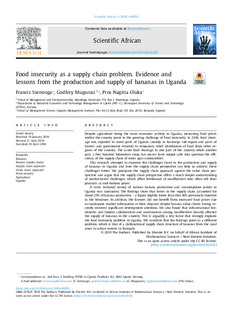| dc.contributor.author | Ssennoga, Francis | |
| dc.contributor.author | Mugurusi, Godfrey | |
| dc.contributor.author | Oluka, Pross Nagitta | |
| dc.date.accessioned | 2019-10-03T08:15:17Z | |
| dc.date.available | 2019-10-03T08:15:17Z | |
| dc.date.created | 2019-05-21T14:19:54Z | |
| dc.date.issued | 2019 | |
| dc.identifier.citation | Scientific African. 2019, 3 (e00076), . | nb_NO |
| dc.identifier.issn | 2468-2276 | |
| dc.identifier.uri | http://hdl.handle.net/11250/2619968 | |
| dc.description.abstract | Despite agriculture being the main economic activity in Uganda, increasing food prices within the country point to the growing challenge of food insecurity. In 2016, food shortage was reported in some parts of Uganda (mainly in Karamoja sub-region and parts of Serere) and government resorted to temporary relief distribution of food from other regions of the country. The acute food shortage in one part of the country while another part, a few hundred kilometers away, has excess farm output calls into question the efficiency of the supply chain of some agro-commodities.
This research attempts to examine the challenges faced in the production and supply of bananas in Uganda and how the supply chain perspective can help us address these challenges better. We juxtapose the supply chain approach against the value chain perspective and argue that the supply chain perspective offers a much deeper understanding of market-based challenges, which affect livelihoods of smallholders who often sell their products at rock-bottom prices.
A cross sectional survey of various banana production and consumptions points in Uganda was conducted. The findings show that losses in the supply chain accounted for about 29% of banana production – a figure slightly lower than that 40% previously reported in the literature. In addition, the farmers did not benefit from increased food prices due to inadequate market information at their disposal despite banana value chains having recently received significant development attention. We also found that infrastructural bottlenecks and limited collaboration and coordination among smallholders heavily affected the supply of bananas in the country. This is arguably a key factor that strongly explains the food insecurity problem in Uganda. We conclude that the findings point to a different problem, which is that of a dysfunctional supply chain structure of bananas from the rural areas to urban centres in Kampala. | nb_NO |
| dc.language.iso | eng | nb_NO |
| dc.publisher | Elsevier | nb_NO |
| dc.rights | Navngivelse 4.0 Internasjonal | * |
| dc.rights.uri | http://creativecommons.org/licenses/by/4.0/deed.no | * |
| dc.title | Food insecurity as a supply chain problem. Evidence and lessons from the production and supply of bananas in Uganda | nb_NO |
| dc.type | Journal article | nb_NO |
| dc.type | Peer reviewed | nb_NO |
| dc.description.version | publishedVersion | nb_NO |
| dc.source.volume | 3 | nb_NO |
| dc.source.journal | Scientific African | nb_NO |
| dc.source.issue | e00076 | nb_NO |
| dc.identifier.doi | 10.1016/j.sciaf.2019.e00076 | |
| dc.identifier.cristin | 1699191 | |
| dc.description.localcode | This article is available under the terms of the Creative Commons Attribution License (CC BY). You may copy and distribute the article, create extracts, abstracts and new works from the article, alter and revise the article, text or data mine the article and otherwise reuse the article commercially (including reuse and/or resale of the article) without permission from Elsevier. You must give appropriate credit to the original work, together with a link to the formal publication through the relevant DOI and a link to the Creative Commons user license above. You must indicate if any changes are made but not in any way that suggests the licensor endorses you or your use of the work. | nb_NO |
| cristin.unitcode | 194,60,25,0 | |
| cristin.unitname | Institutt for industriell økonomi og teknologiledelse | |
| cristin.ispublished | true | |
| cristin.fulltext | original | |
| cristin.qualitycode | 1 | |

